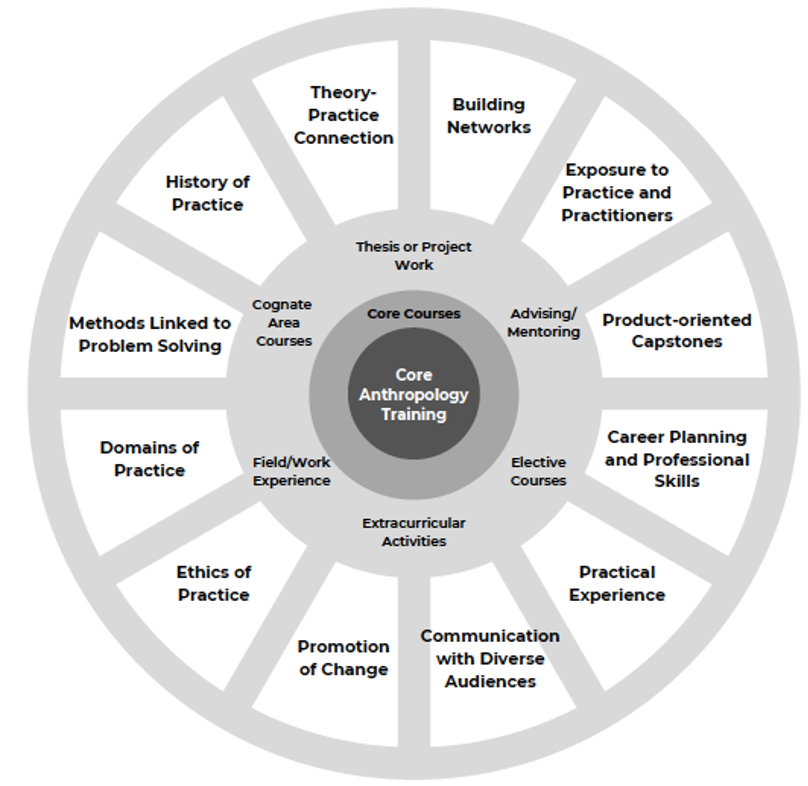An account is required to join the Society, renew annual memberships online, register for the Annual Meeting, and access the journals Practicing Anthropology and Human Organization
- Hello Guest!|Log In | Register
Career Readiness Commission
Elizabeth K. Briody and Riall W. Nolan
Anthropology’s Career Readiness Commission welcomes you to participate in all activities! Our mission is to improve the preparation of students for careers in industry, non-profits, and government. The Commission has taken on numerous challenges, two of which are discussed in this newsletter: a Career Ready Curriculum Framework and One-page Tools.
A Career Ready Curriculum Framework
We often hear that anthropology instructors do not feel equipped to teach students how to prepare for careers in industry, non-profits, and government. Our response: No need to worry! The Commission has developed a new framework that can guide individual instructors as well as entire anthropology programs.
The Career Ready Curriculum
 Instructors will recognize the center of the graphic as the key components of anthropology training today. Along the periphery are 12 elements that will help students prepare for their future.
Instructors will recognize the center of the graphic as the key components of anthropology training today. Along the periphery are 12 elements that will help students prepare for their future.
For example, the “Theory-Practice Connection” element will enable students to understand how theory and practice are a two-way street. Just as theory is useful in explaining phenomena, practice is helpful in developing new theory and in building and testing existing theory.
“Communication with Diverse Audiences” highlights the importance of clear, concise communication, whether it is spoken or written. Learning to present results without reading to the audience or writing an op-ed on a particular topic (perhaps in lieu of a term paper) allows students to gain essential experience in sharing their work professionally and confidently with others.
And what about “Exposure to Practice and Practitioners?” This element takes advantage of university alumni and practitioners—anthropologists who are often willing to engage with and assist current students with internship placements, mentoring, professional contacts, and more.
SfAA Newsletter readers may access an earlier version of our report here to learn more about this new framework as well as how the 12 elements may be included in undergraduate and graduate anthropology training. While some more traditional anthropology programs may begin small by integrating a few of these elements into their existing structure, longstanding applied programs will be able to ramp up quickly on those components they have not yet fully incorporated. Regardless of where a program lies with respect to career readiness, this Career Ready Curriculum framework serves as a guide to future planning and development inside anthropology programs.
One-page Tools
We continue to hear how ill-prepared students feel in
1) entering the job market confidently
2) educating potential employers about the relevance and value of anthropology
3) securing a position that allows them to apply their anthropological knowledge.
Commission volunteers began developing (mostly) one-page “tools” to help address these concerns. The tools provide insight and offer advice on specific topics (e.g., job titles held by anthropologists, translating anthropological training into the workplace).
To date, we have designed eight tools for job seekers. Some have exercises so that job seekers can compile, design, and rehearse their ideas. Others have a TikTok video associated with them at anthropology4u courtesy of Keirsten Snover such as this one. The Commission’s newest tools include:
• Mastering the Elevator Pitch
• Networking Basics and Informational Interviews
• LinkedIn Profile Checklist.
Check them all out here, just scroll down. New tools under development include:
• Understanding Differences between CVs, Resumes, Portfolios, and Bios
• Writing a Great Cover Letter.
Similarly, we have created seven tools for instructors. These tools offer insight and support for integrating workplace skills into the curriculum. For example, to enable students to get hands-on experience working on a current problem for a “real” client, we suggest this tool:
• Client-based Class Project.
The Commission worked with two universities this fall on class projects: Western University (Ontario) and University of Delaware. In the spring, it will work with Indiana University and with SUNY Albany.
Or perhaps you want to know what kinds of training practitioners believe would have been useful to them when they were in school. If so, consult the bar graphs on this tool:
• What’s Missing from Anthropology Training?
Check out all the tools for instructors here by scrolling down. A new tool for instructors is being developed right now:
• Alumni Value to Current Students.
It focuses on reaching out to alums to help educate today’s students about the workplace.
Please Join Us
The Commission welcomes the participation of any SfAA Newsletter readers who have not yet been involved in our efforts. To get on our mailing list, simply fill out this form and you will automatically be invited to our bi-monthly Zoom meetings and receive our Newsletter on the odd month.
If you would like to work on any of our projects, or propose a new project, we would welcome it. It is only because of our dedicated volunteers that we have been able to accomplish so much over the last 20 months. Feel free to reach out to elizabeth.briody@gmail.com or rwnolan@purdue.edu for more information.


Cart
Search